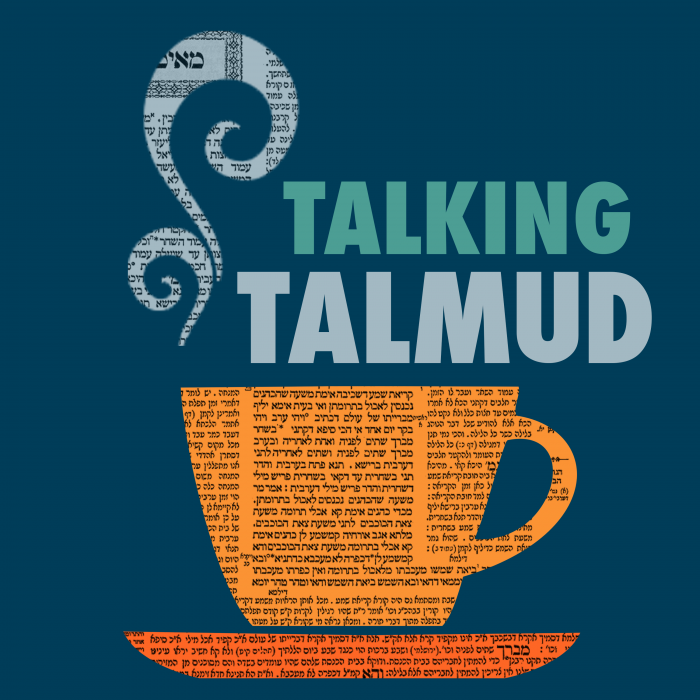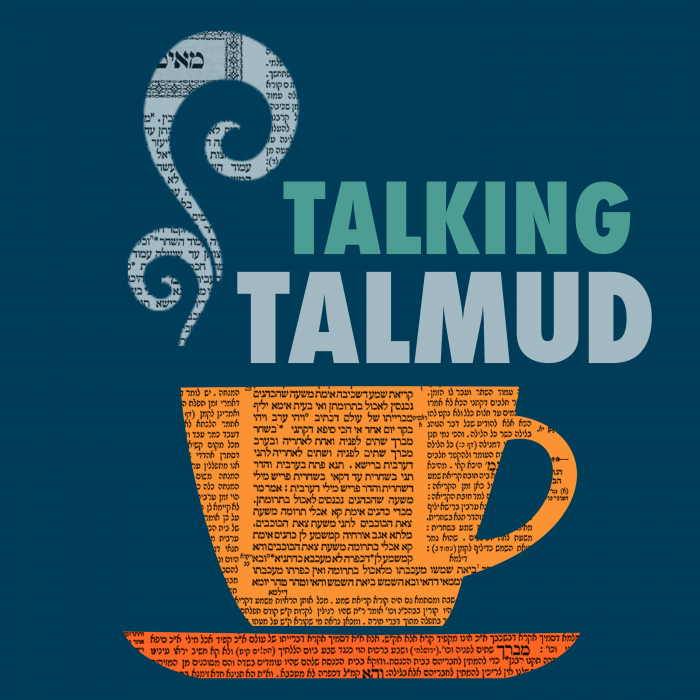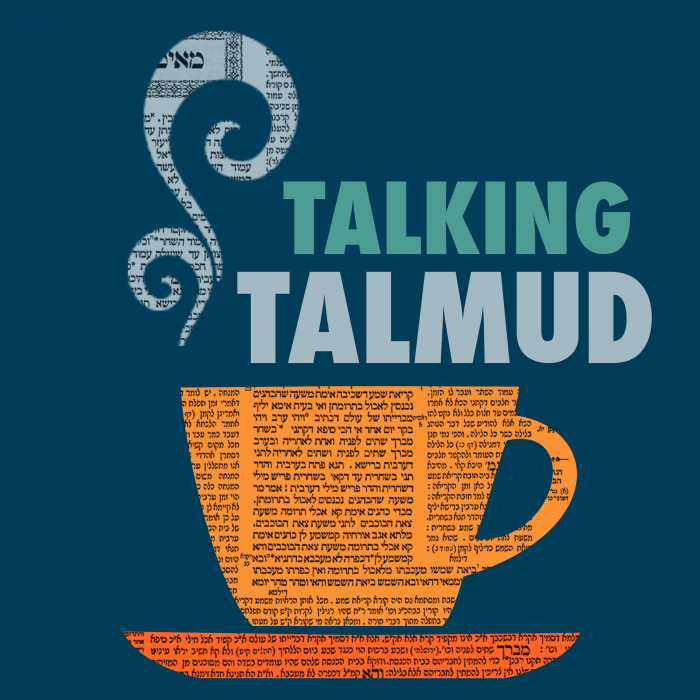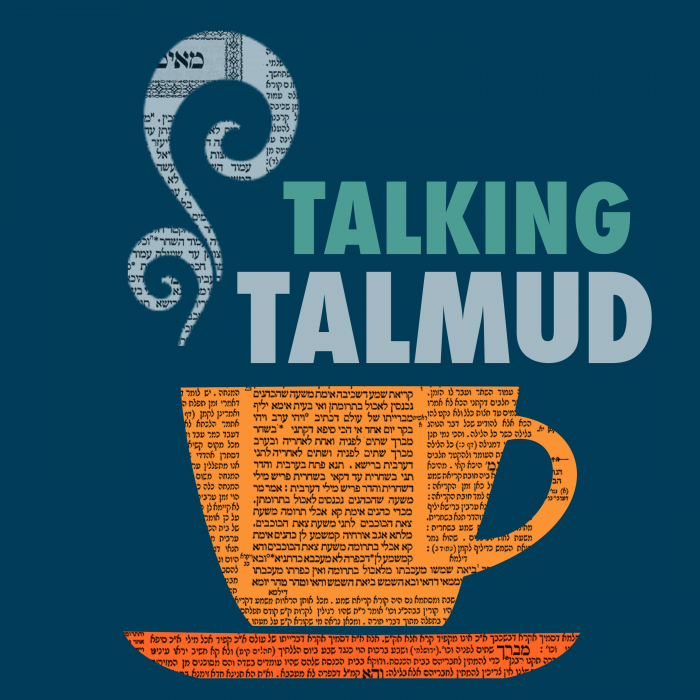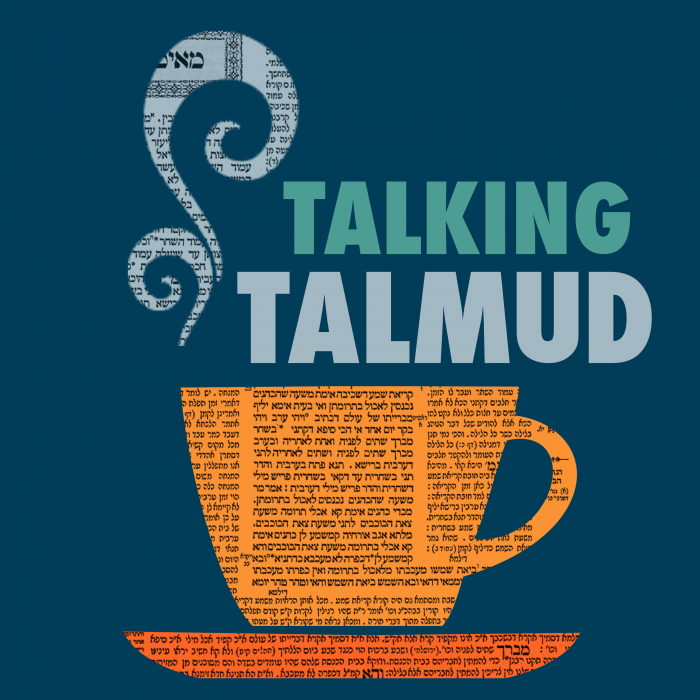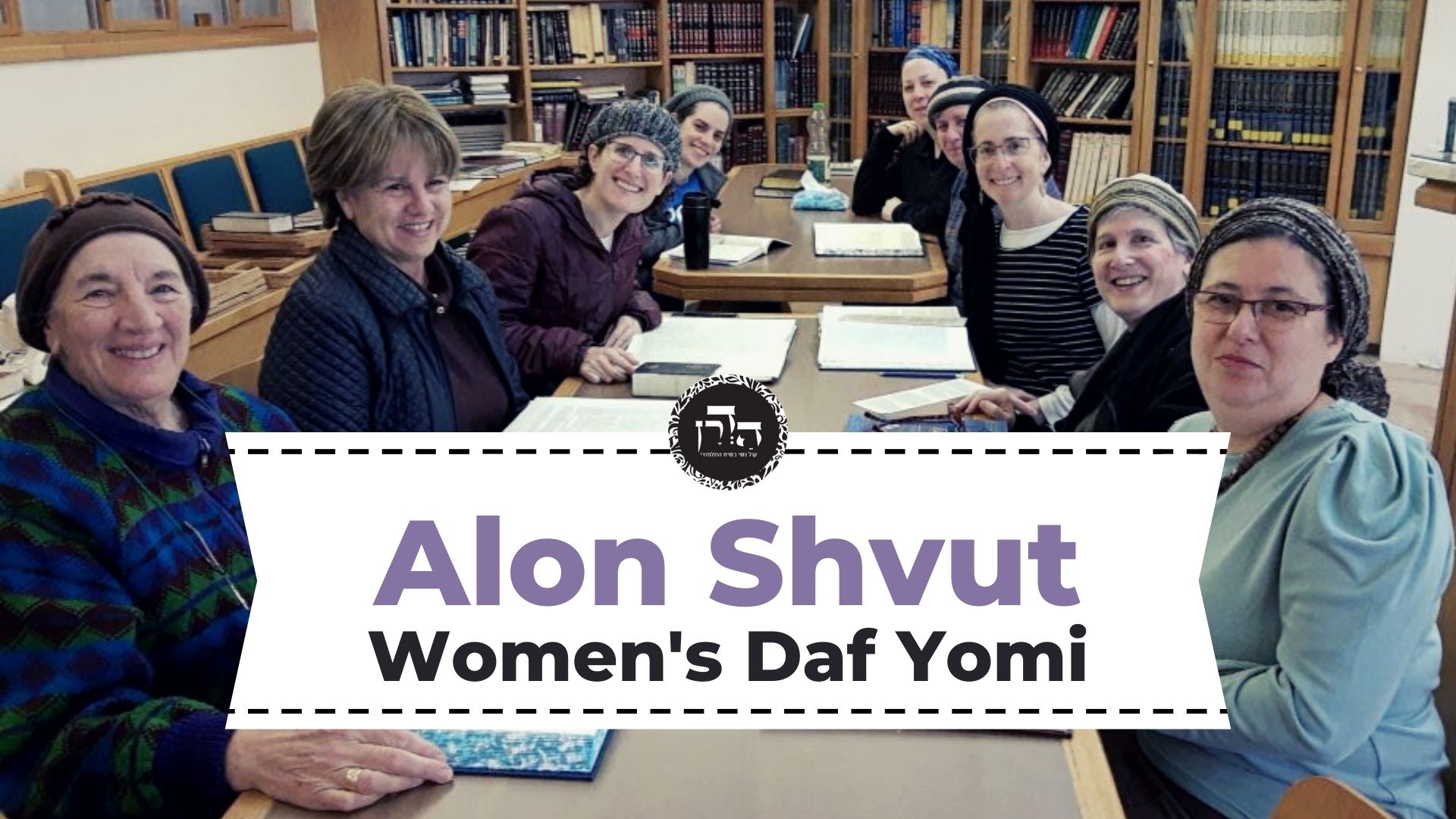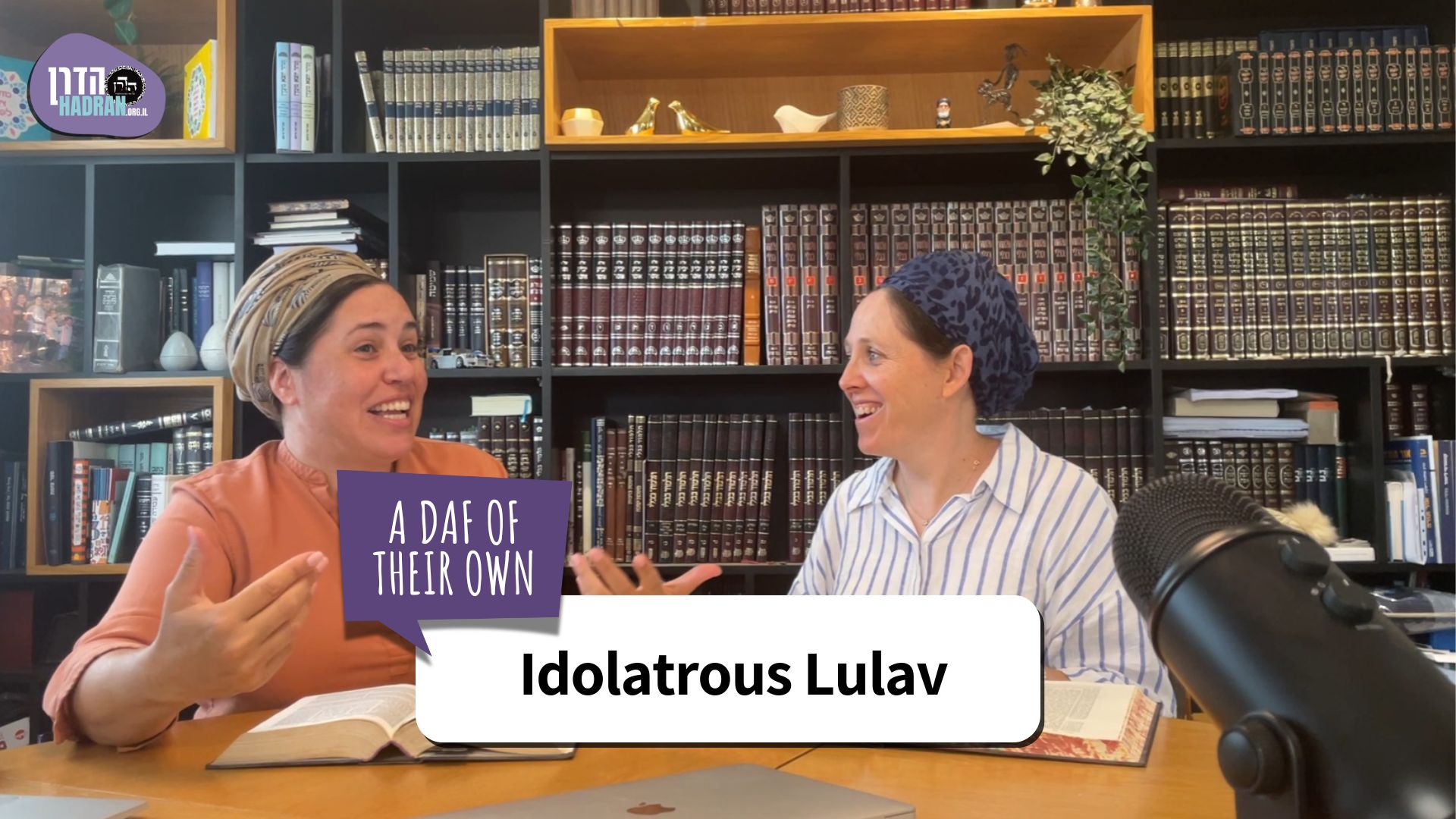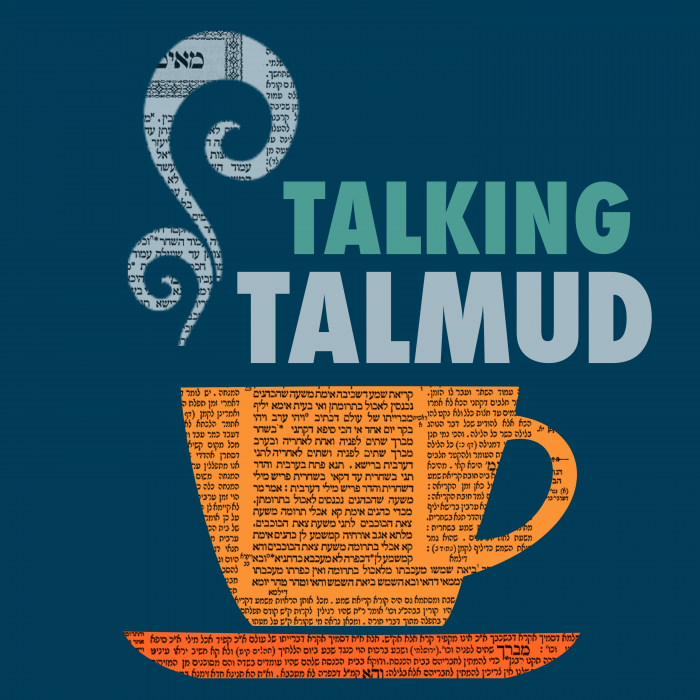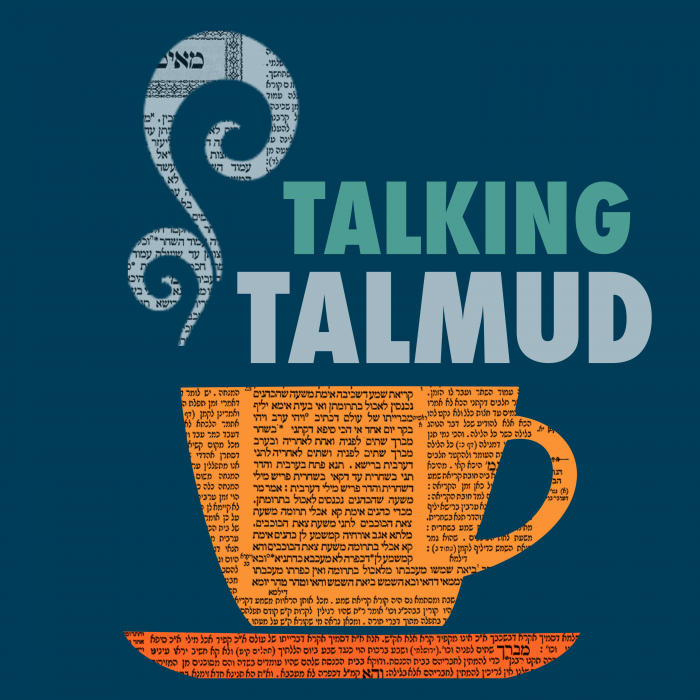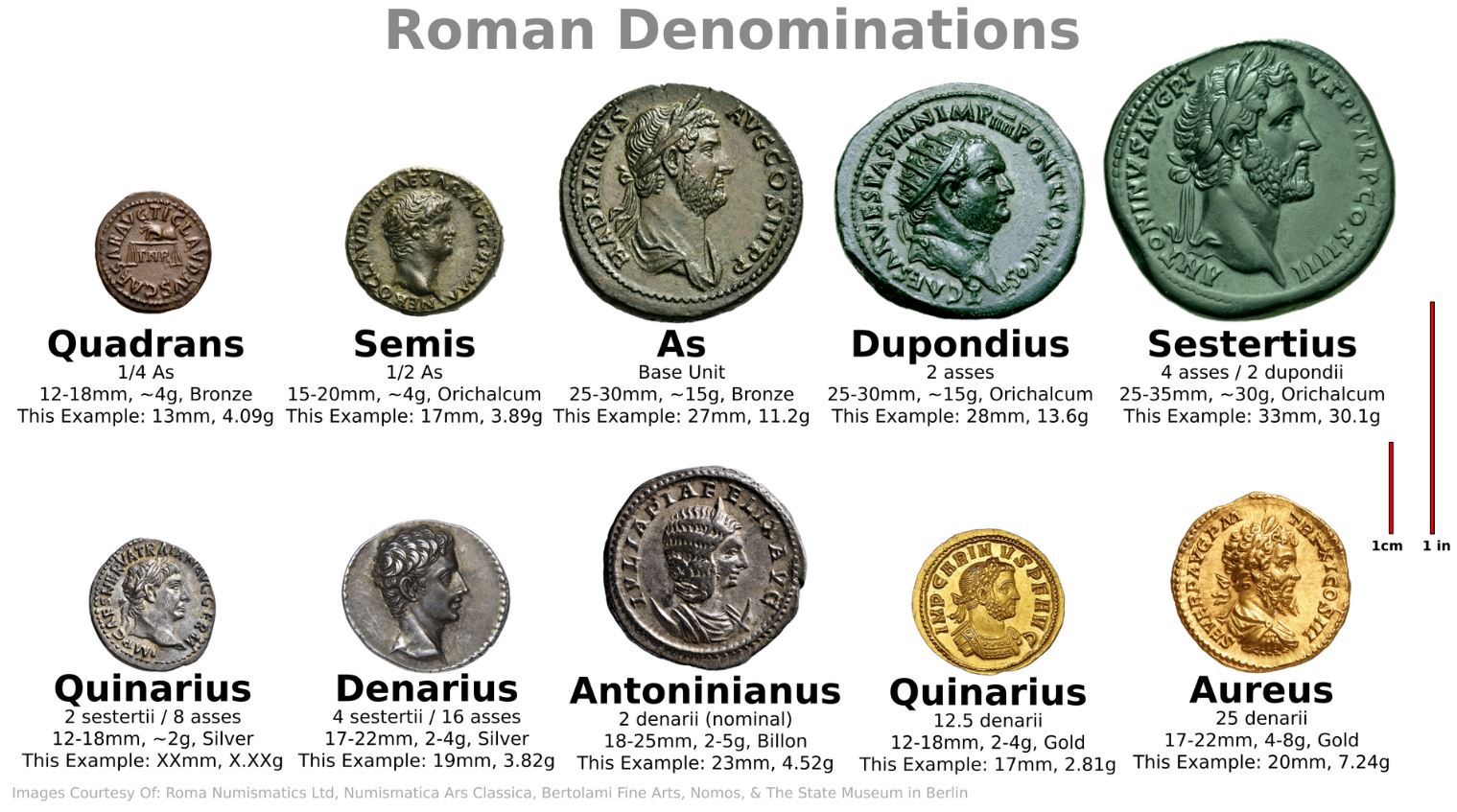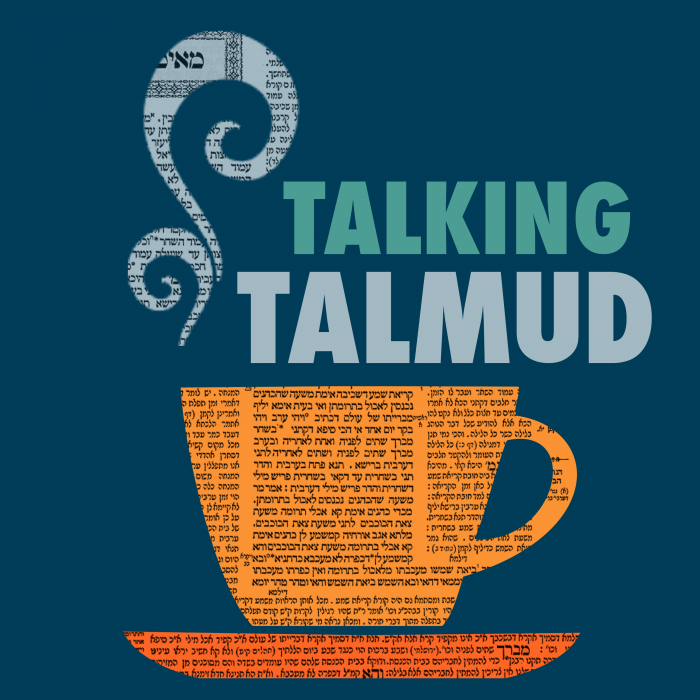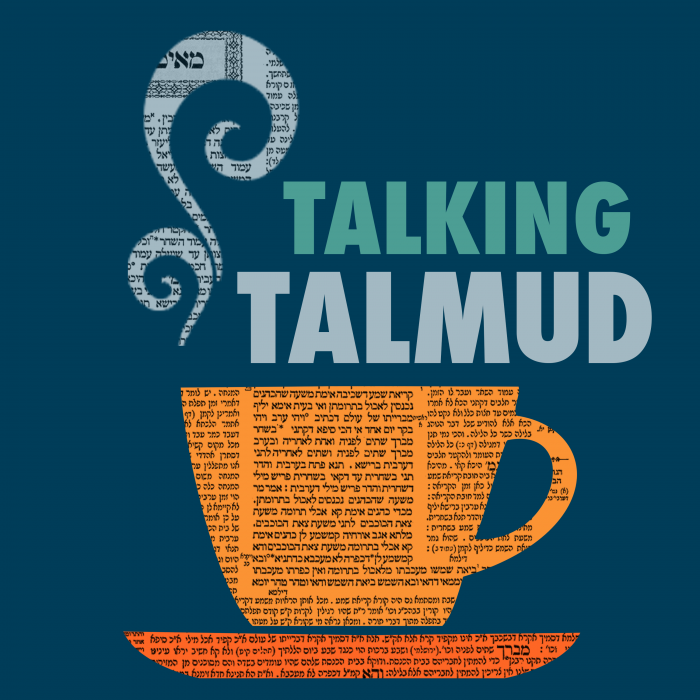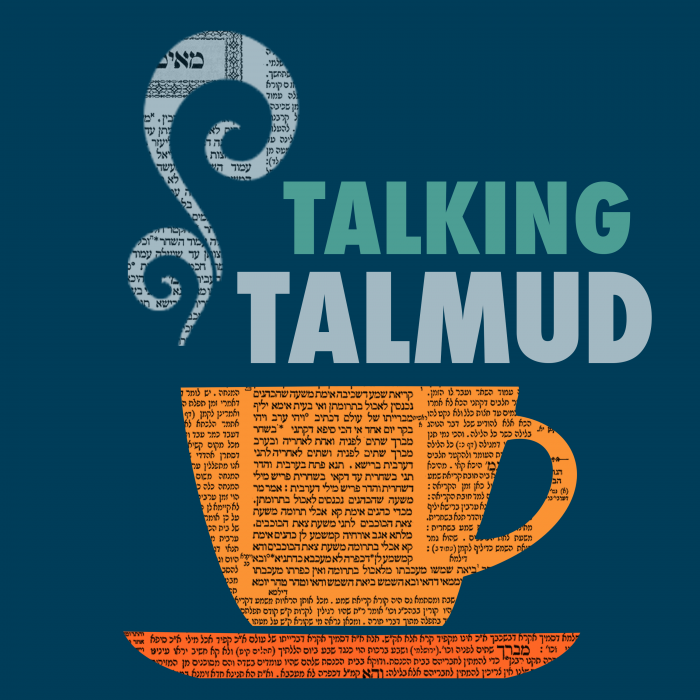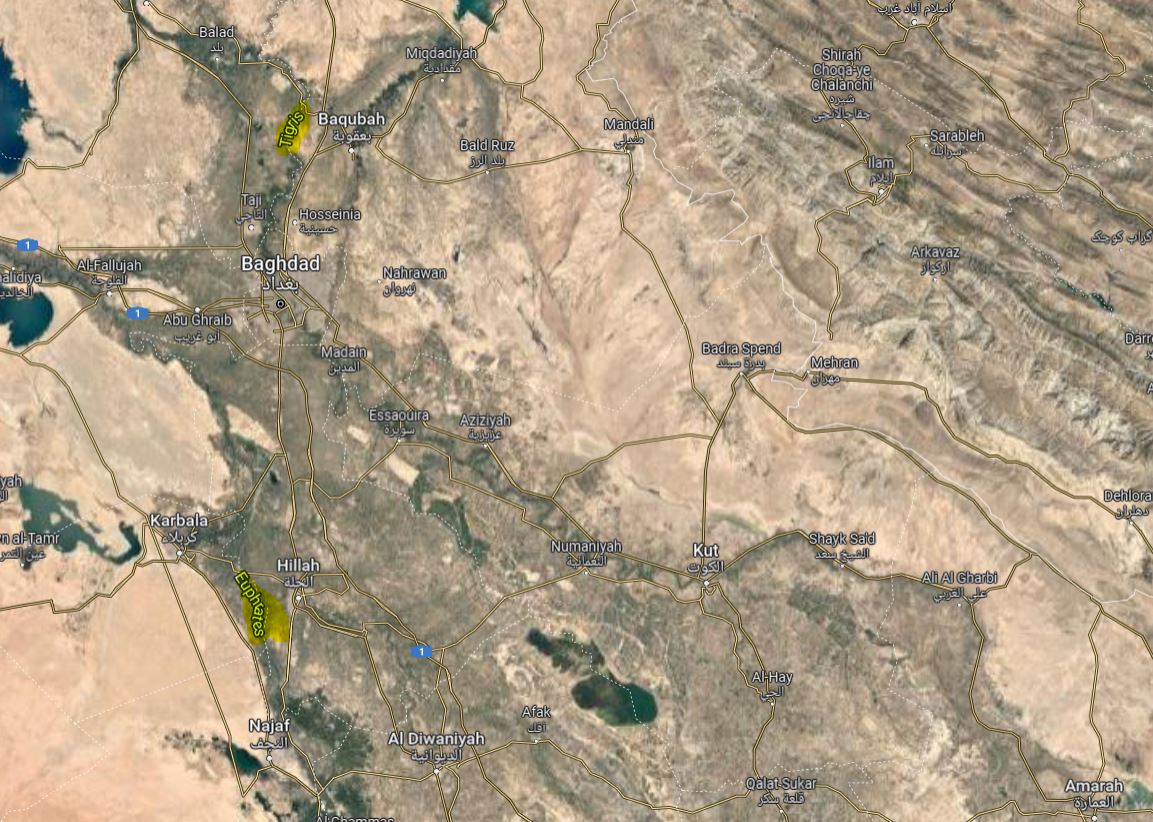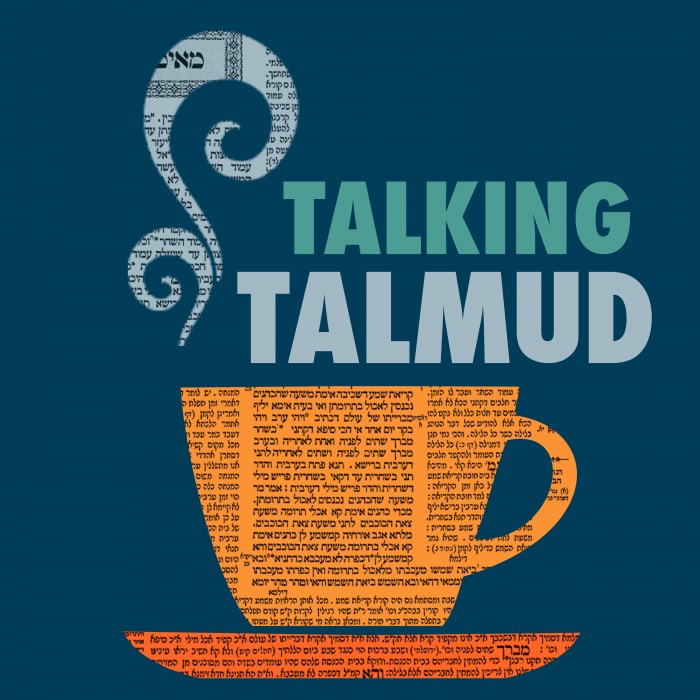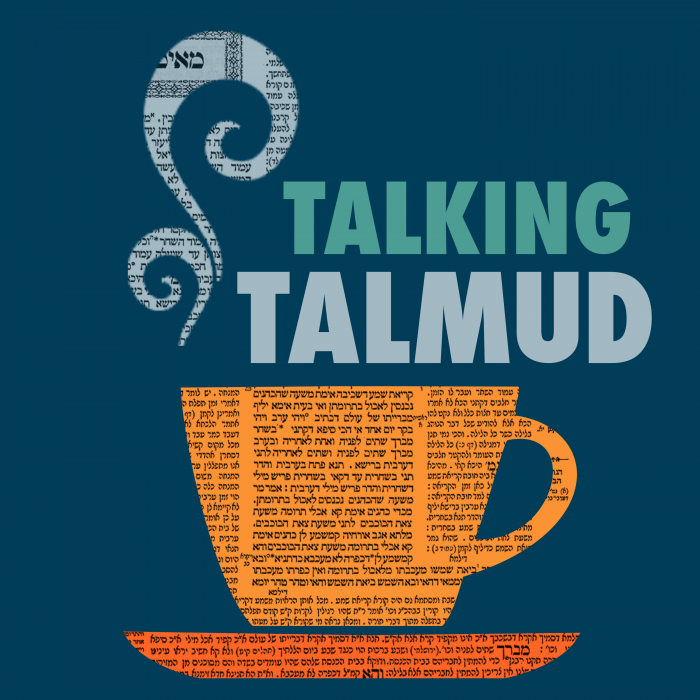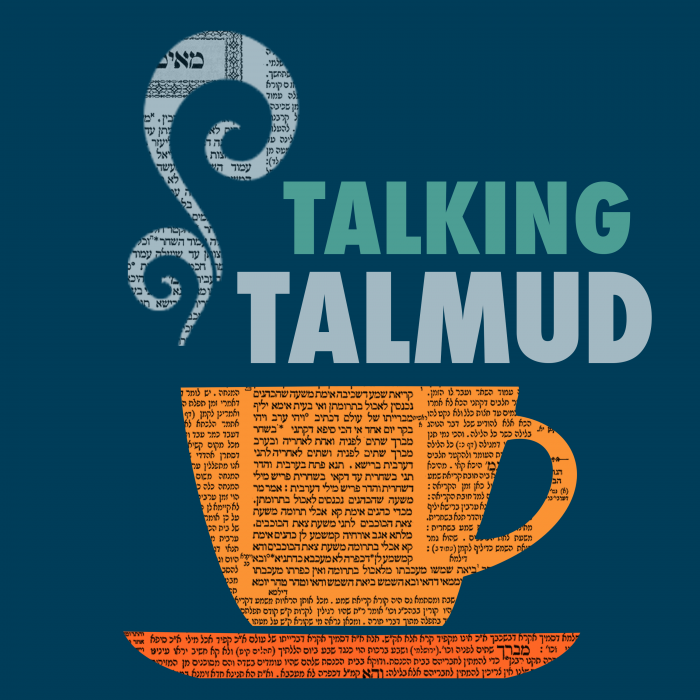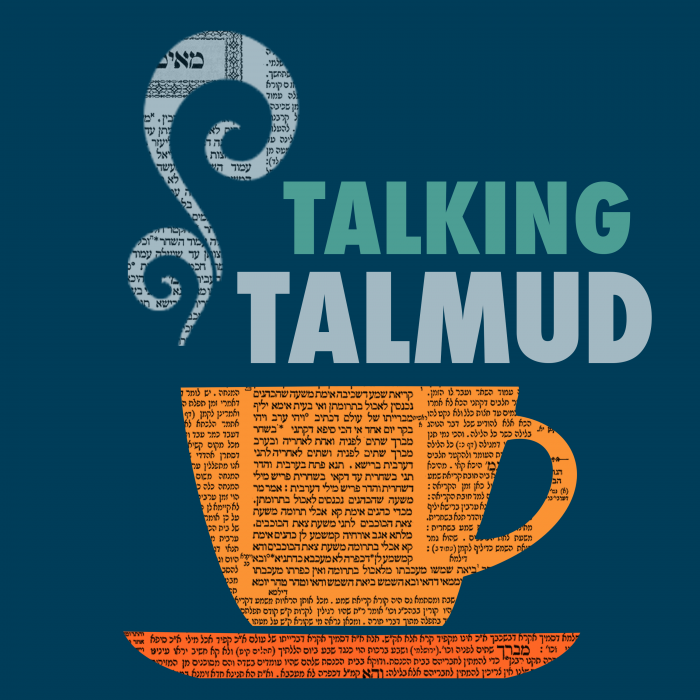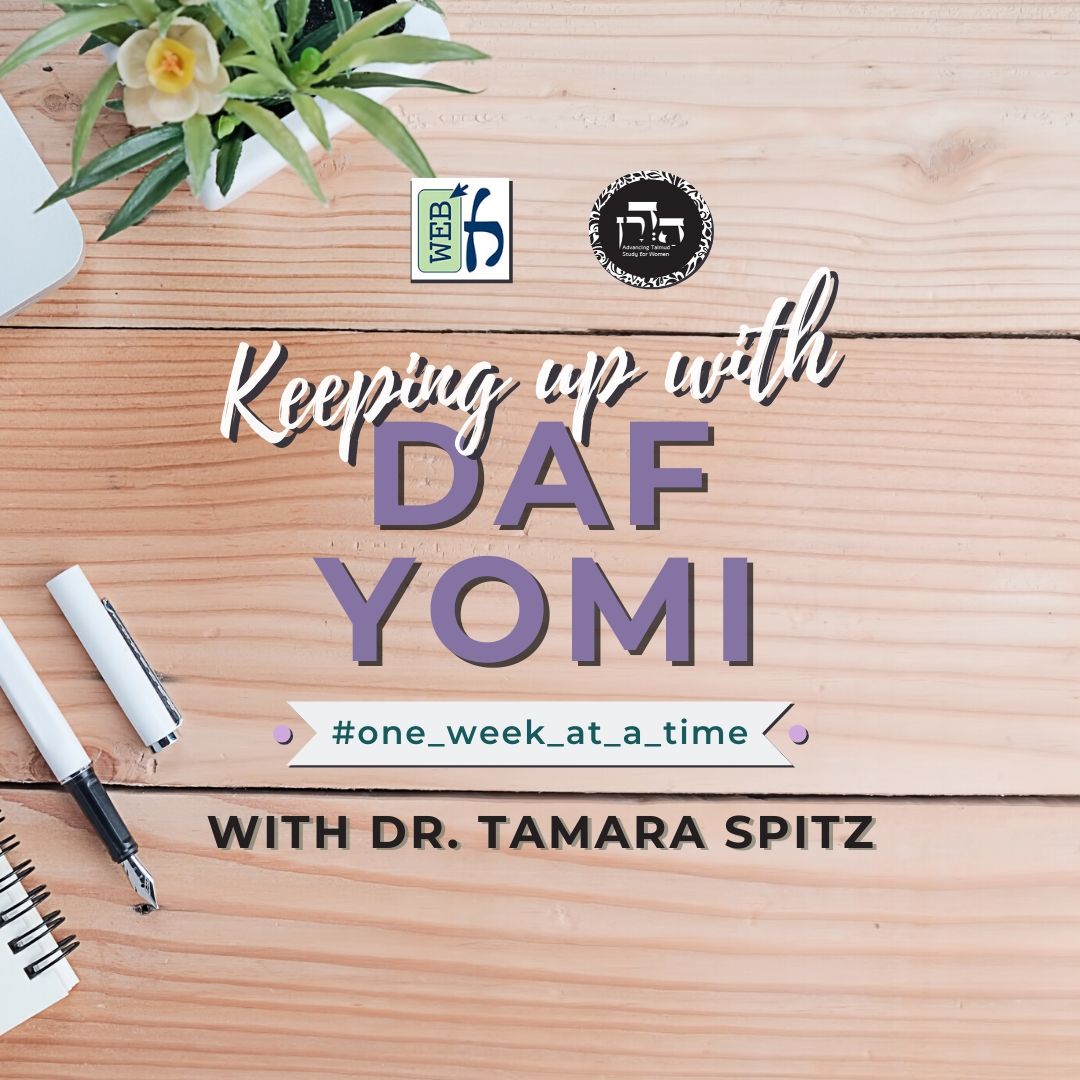What are the different approaches to the types of sanctified items that need to stand up in order to be evaluated? The gemara explains the various laws in the mishna relating to a sanctified sacrificial animal that became disqualified and finds their source in the verses in the Torah.
This week’s learning is sponsored by Robert and Paula Cohen in loving memory of Joseph Cohen, Yosef ben Moshe HaCohen, z”l. “He was hard working, loved to sing, esp. as a chazan, and was very dedicated to his family and community.”
Want to dedicate learning? Get started here:


Today’s daily daf tools:
This week’s learning is sponsored by Robert and Paula Cohen in loving memory of Joseph Cohen, Yosef ben Moshe HaCohen, z”l. “He was hard working, loved to sing, esp. as a chazan, and was very dedicated to his family and community.”
Today’s daily daf tools:
Delve Deeper
Broaden your understanding of the topics on this daf with classes and podcasts from top women Talmud scholars.
New to Talmud?
Check out our resources designed to help you navigate a page of Talmud – and study at the pace, level and style that fits you.
The Hadran Women’s Tapestry
Meet the diverse women learning Gemara at Hadran and hear their stories.
Bekhorot 15
״זוֹ דִּבְרֵי רַבִּי שִׁמְעוֹן וּמַחְלוּקְתּוֹ״ מִיבַּעְיָא לֵיהּ!
Since both Rabbi Shimon and the Rabbis agree that an animal which was blemished before it was consecrated can be redeemed, he should have said: This is the statement of Rabbi Shimon and those who disagree with him.
אָמְרִי: רַב כְּרַבִּי שִׁמְעוֹן בֶּן לָקִישׁ, דְּאָמַר לְרַבָּנַן: קׇדְשֵׁי בֶּדֶק הַבַּיִת הָיוּ בִּכְלַל הַעֲמָדָה וְהַעֲרָכָה, קׇדְשֵׁי מִזְבֵּחַ לֹא הָיוּ בִּכְלַל הַעֲמָדָה וְהַעֲרָכָה, וְלָא מִיתּוֹקְמָא מַתְנִיתִין כְּרַבָּנַן, דְּקָתָנֵי סֵיפָא: וְאִם מֵתוּ יִקָּבֵרוּ.
The Sages said in response that Rav holds in accordance with the opinion of Rabbi Shimon ben Lakish, who says: According to the Rabbis, animals consecrated for the Temple maintenance were included in the obligation of standing and valuation, whereas animals consecrated for the altar were not included in the obligation of standing and valuation. And therefore it is not possible to interpret the mishna in accordance with the opinion of the Rabbis, as the latter clause teaches: And if animals consecrated for the altar died, they must be buried even if their consecration preceded their blemish, as they are included in the obligation of standing and valuation.
אָמַר: מִמַּאי דְּהָא ״מֵתוּ יִקָּבֵרוּ״ מִשּׁוּם דְּבָעֵי הַעֲמָדָה וְהַעֲרָכָה הוּא? דִּלְמָא מִשּׁוּם דְּאֵין פּוֹדִין אֶת הַקֳּדָשִׁים לְהַאֲכִילָן לִכְלָבִים הוּא! אָמְרִי: אִם כֵּן, נִיתְנֵי: ״אִם נַעֲשׂוּ טְרֵיפָה יִקָּבֵרוּ״.
The Gemara says: From where is it known that this ruling of the mishna: If they died they must be buried, is due to the fact that they require standing and valuation? Perhaps it is because one may not redeem sacrificial animals in order to feed them to dogs. The Sages said in response: If that were so, let the mishna teach: If one of them became an animal with a wound that will cause it to die within twelve months [tereifa], it must be buried. Since a tereifa can be stood before the priest, the only reason to require its burial must be due to the prohibition against redeeming a sacrificial animal in order to feed it to dogs.
וְאִיבָּעֵית אֵימָא: לְעוֹלָם רַב כְּרַבִּי יוֹחָנָן סְבִירָא לֵיהּ, וּתְנִי: זוֹ דִּבְרֵי רַבִּי שִׁמְעוֹן וּמַחְלוּקְתּוֹ.
And if you wish, say instead: Actually, Rav holds in accordance with the opinion of Rabbi Yoḥanan, who says that according to the Rabbis, animals consecrated for the altar were included in the obligation of standing and appraising, and therefore the mishna can be explained in accordance with the opinion of the Rabbis. And in fact Rav taught: This is the statement of Rabbi Shimon and those who disagree with him.
אֲבָל קָדַם הֶקְדֵּשָׁן וְכוּ׳. מְנָא הָנֵי מִילֵּי? דְּתָנוּ רַבָּנַן: ״צְבִי״, מָה צְבִי פָּטוּר מִן הַבְּכוֹרָה, אַף פְּסוּלֵי הַמּוּקְדָּשִׁין פְּטוּרִין מִן הַבְּכוֹרָה.
§ The mishna teaches: But if their consecration preceded their blemish, they are exempt from the mitzva of the firstborn and from the priestly gifts. The Gemara asks: From where are these matters derived? They are derived from a verse, as the Sages taught with regard to a verse discussing disqualified consecrated animals: “However, as you eat the gazelle and the hart, so shall you eat thereof” (Deuteronomy 12:22). Just as a gazelle is exempt from the mitzva of the firstborn, as this obligation does not apply to undomesticated animals, so too, disqualified consecrated animals are exempt from the mitzva of the firstborn.
אוֹצִיא אֲנִי אֶת הַבְּכוֹרָה, וְלֹא אוֹצִיא אֶת הַמַּתָּנוֹת? תַּלְמוּד לוֹמַר: ״אַיָּל״, מָה אַיָּל פָּטוּר מִן הַבְּכוֹרָה וּמִן הַמַּתָּנוֹת, אַף פְּסוּלֵי הַמּוּקְדָּשִׁין פְּטוּרִין מִן הַבְּכוֹרָה וּמִן הַמַּתָּנוֹת.
The baraita continues: Based on this derivation, I will exclude consecrated animals that developed a blemish from the mitzva of the firstborn but I will not exclude them from the mitzva of the gifts. From where is it derived that such animals are not subject to the mitzva of the gifts either? The Gemara answers that the verse states: “However, as you eat the gazelle and the hart.” This teaches that just as a hart is exempt from the mitzva of the firstborn and from the mitzva of the gifts, so too, disqualified consecrated animals are exempt from the mitzva of the firstborn and from the mitzva of the gifts.
אִי מָה צְבִי וְאַיָּל חֶלְבָּן מוּתָּר, אַף פְּסוּלֵי הַמּוּקְדָּשִׁין חֶלְבָּן מוּתָּר? תַּלְמוּד לוֹמַר: ״אַךְ״ — חִלֵּק.
The Gemara asks: If so, then it follows that just as the fat of a gazelle and a hart is permitted, so too, the fat of disqualified consecrated animals should be permitted. In fact, the halakha is that the fat of disqualified consecrated animals is forbidden, like that of other domesticated animals. The baraita answers that the verse states: “However, as you eat the gazelle and the hart.” The term “however” differentiates, i.e., it serves to limit the analogy between these animals to the mitzvot of the firstborn and the gifts, and not forbidden fat.
אָמַר מָר: אוֹצִיא אֶת הַבְּכוֹר, וְלֹא אוֹצִיא אֶת הַמַּתָּנוֹת. מַאי שְׁנָא אוֹצִיא אֶת הַבְּכוֹר — שֶׁאֵין שָׁוֶה בַּכֹּל, וְלֹא אוֹצִיא אֶת הַמַּתָּנוֹת — שֶׁשָּׁווֹת בַּכֹּל. תַּלְמוּד לוֹמַר: ״אַיָּל״.
The Gemara analyzes the baraita. The Master said: I will exclude consecrated animals that developed a blemish from the mitzva of the firstborn but I will not exclude them from the mitzva of the gifts. The Gemara asks: What is different about a firstborn that I would exclude only the mitzva of the firstborn, in the first stage of this interpretation? Why not exclude the mitzva of the gifts as well? The Gemara answers that the mitzva of the firstborn does not apply equally to all animals but only to males, and therefore I do not initially exclude the mitzva of the gifts, as they do apply equally to all domesticated animals, including females. Therefore, when the verse states “a hart” in addition to the gazelle, this is derived as teaching that disqualified consecrated animals are excluded from the mitzva of the gifts as well.
אֲמַר לֵיהּ רַב פָּפָּא לְאַבָּיֵי: אִי מָה צְבִי וְאַיָּל, אֵין אוֹתוֹ וְאֶת בְּנוֹ נוֹהֵג בָּהֶן, אַף פְּסוּלֵי הַמּוּקְדָּשִׁין אֵין אוֹתוֹ וְאֶת בְּנוֹ נוֹהֵג בּוֹ!
Rav Pappa said another question to Abaye: If one accepts the analogy between disqualified consecrated animals and the animals mentioned in the verse, then one can claim as follows: Just as the prohibition against slaughtering an animal itself and its offspring on the same day does not apply to a gazelle and a hart, so too, the prohibition against slaughtering an animal itself and its offspring should not apply to disqualified consecrated animals. Why does the baraita not address this issue?
אֲמַר לֵיהּ: לְמַאי מְדַמֵּית לְהוּ? אִי לְחוּלִּין — ״אוֹתוֹ וְאֶת בְּנוֹ״ נוֹהֵג בּוֹ, וְאִי לְקָדָשִׁים — ״אוֹתוֹ וְאֶת בְּנוֹ״ נוֹהֵג בּוֹ!
Abaye said to Rav Pappa: To what are you comparing disqualified consecrated animals? If you are comparing them to non-sacred domesticated animals, the prohibition against slaughtering a mother and its offspring on the same day applies to them. And if you are comparing them to sacrificial animals, the prohibition against slaughtering an animal itself and its offspring also applies to them. Since all domesticated animals are subject to the prohibition against slaughtering a mother and its offspring, one cannot derive the exclusion of disqualified consecrated animals from this verse.
אֲמַר לֵיהּ: אִי הָכִי, גַּבֵּי חֶלְבּוֹ נָמֵי נֵימָא הָכִי: לְמַאי מְדַמֵּית לְהוּ? אִי לְחוּלִּין — חֶלְבָּן אָסוּר, וְאִי לְקָדָשִׁים — חֶלְבָּן אָסוּר!
Rav Pappa said to him: If so, then with regard to its fat as well, let us state a claim like this: To what are you comparing disqualified animals? If you are comparing them to non-sacred animals, their fat is forbidden. And if you are comparing them to sacrificial animals, their fat is also forbidden. Since the prohibition of fat also applies to both consecrated and non-sacred animals, by the same reasoning there is no need for the verse to teach that the prohibition of fat applies. Nevertheless, the baraita derives this halakha from the word “however.”
אֶלָּא, לָאו מִי אָמְרַתְּ ״אַךְ״ וְלֹא חֶלְבָּן? אֵימַר נָמֵי ״אַךְ״ וְלֹא אוֹתוֹ וְאֶת בְּנוֹ.
Rather, didn’t you say in the baraita: “However,” but not their fat? Say also: “However,” but not a mother and its offspring. With regard to both halakhot, which apply to domesticated but not undomesticated animals, the reason that the analogy is not extended is not due to Abaye’s claim, as the juxtaposition between the animals would teach that their halakhot are the same. Instead, both exclusions are derived equally from the word “however,” which serves to differentiate disqualified consecrated animals from the gazelle and the hart both with regard to forbidden fat and with regard to the prohibition against slaughtering a mother and its offspring. Interpreting the exclusion in this manner means that disqualified consecrated animals are at least comparable to sacrificial animals in that they are excluded from the mitzva of the firstborn and the priestly gifts. Had the exclusion been interpreted with regard to the mitzva of the firstborn and the priestly gifts, disqualified consecrated animals would not be comparable to any type of animal.
רָבָא אָמַר: ״אַךְ״ לְאוֹתוֹ וְאֶת בְּנוֹ הוּא דַּאֲתָא, וְחֶלְבּוֹ מִ״דָּמוֹ״ נָפְקָא, דִּכְתִיב: ״רַק אֶת דָּמוֹ לֹא תֹאכֵל״.
The Gemara cites a different interpretation. Rava says: The word “however” comes to exclude the prohibition against slaughtering a mother and its offspring from the comparison between disqualified consecrated animals and the gazelle and hart, and the exclusion of its fat is derived from the term “its blood.” As it is written with regard to a blemished firstborn animal: “You shall eat it…as the gazelle, and as the hart. Only you shall not eat its blood” (Deuteronomy 15:22–23).
מַאי ״דָּמוֹ״? אִילֵּימָא דָּמוֹ מַמָּשׁ, לָא יְהֵא אֶלָּא דָּמָן דִּצְבִי וְאַיָּל, אַטּוּ דָּמָן דִּצְבִי וְאַיָּל מִי שְׁרֵי? אֶלָּא ״דָּמוֹ״ — חֶלְבּוֹ.
Rava elaborates: What is “its blood” referring to? If we say that it is referring to its actual blood, the Torah would not have had to state this explicitly, as even if it were merely similar to the blood of a gazelle and a hart, is that to say that anyone permits the blood of a gazelle and a hart? Since the blood of all animals is forbidden, it is already established that the blood of a blemished firstborn animal is forbidden. Rather, the term “its blood” is referring to its fat.
וְלִיכְתּוֹב רַחֲמָנָא ״חֶלְבּוֹ״! אִי כְּתַב רַחֲמָנָא ״חֵלֶב״, הֲוָה אָמֵינָא: אַהֲנִי הֶיקֵּישָׁא וְאַהֲנִי קְרָא.
The Gemara challenges: But in that case, let the Merciful One write: Its fat, instead of “its blood.” The Gemara explains: If the Merciful One had written fat, I would say: The juxtaposition between disqualified consecrated animals and a gazelle and a hart is effective with regard to fat, and the verse itself is also effective, i.e., it can be derived from the juxtaposition and the verse together that the prohibition of fat applies to disqualified consecrated animals to a certain extent, but not fully.
אַהֲנִי הֶיקֵּישָׁא לְמַעוֹטֵי מִכָּרֵת, דְּכִי כְּתַב כָּרֵת — אַאוֹכֵל חֵלֶב בְּהֵמָה הוּא דִּכְתִיב, שֶׁנֶּאֱמַר: ״כִּי כׇל אוֹכֵל חֵלֶב מִן הַבְּהֵמָה״.
The Gemara elaborates: The juxtaposition is effective in that it excludes one who eats the fat of consecrated animals from the punishment of excision from the World-to-Come [karet]. The reason is that when the Merciful One writes “karet,” it is written with regard to one who eats the fat of a domesticated animal, as it is stated: “For anyone who eats the fat of the domesticated animal…even the soul that eats it shall be excised from his people” (Leviticus 7:25). The juxtaposition to a gazelle and a hart would teach that the punishment of karet does not apply in the case of disqualified consecrated animals.
וְאַהֲנִי קְרָא לְמֵיקַם עֲלֵיהּ בְּלָאו בְּעָלְמָא, לְהָכִי אַפְּקֵיהּ רַחֲמָנָא בִּלְשׁוֹן ״דָּמוֹ״, לוֹמַר לָךְ: מָה דָּמוֹ בְּכָרֵת — אַף חֶלְבּוֹ בְּכָרֵת.
And at the same time the verse in Deuteronomy 15:23 would also be effective, as, if it were written: Only you shall not eat its fat, it would establish the consumption of the fat of disqualified consecrated animals as a prohibition for which one is liable merely to receive lashes. For this reason, the Merciful One expresses the prohibition against eating the fat using the language “its blood,” in order to tell you that just as consumption of its blood is punishable by karet, so too, consumption of its fat is punishable by karet. By using the term “its blood,” the Torah conveys that one is liable to receive karet for eating the fat of disqualified consecrated animals, i.e., that with regard to this particular halakha the juxtaposition does not apply at all.
וְהָא תָּנָא ״אַךְ״, וְלֹא חֶלְבּוֹ, קָאָמַר!
Rava stated that the halakha with regard to the consumption of the fat of a disqualified consecrated animal is derived from the verse: “Only shall you not eat its blood.” The Gemara asks: But didn’t the tanna of the baraita say that the word “however” limits the juxtaposition so that disqualified consecrated animals are not included in the mitzvot of the firstborn and the gifts, but they are not excluded from the prohibition against eating its fat? How can Rava suggest a different source than the one cited in the baraita?
הָכִי קָאָמַר: אִילּוּ לֹא נֶאֱמַר ״דָּמוֹ״, הָיִיתִי אוֹמֵר ״אַךְ״ — וְלֹא חֶלְבּוֹ, עַכְשָׁיו שֶׁנֶּאֱמַר ״דָּמוֹ״, לְאוֹתוֹ וְאֶת בְּנוֹ הוּא דַּאֲתָא.
The Gemara answers that according to Rava, this is what the baraita is saying: Had the term “its blood” not been stated, I would have said that the word “however” teaches: But not its fat. But now that it is stated: “Its blood,” the word “however” comes to teach that the prohibition against slaughtering a mother and its offspring on the same day applies to disqualified consecrated animals.
וְאֵינָן יוֹצְאִין לְחוּלִּין. מְנָא הָנֵי מִילֵּי? דְּתָנוּ רַבָּנַן: ״תִּזְבַּח״ — וְלֹא גִּיזָּה, ״בָּשָׂר״ — וְלֹא חָלָב, ״וְאָכַלְתָּ״ — וְלֹא לִכְלָבֶיךָ, מִכָּאן שֶׁאֵין פּוֹדִין אֶת הַקֳּדָשִׁים לְהַאֲכִילָן לִכְלָבִים.
§ The mishna teaches: And animals whose consecration preceded their blemish do not completely emerge from their sacred status and assume non-sacred status in order to be shorn and to be utilized for labor. The Gemara asks: From where are these matters derived? They are derived from a verse, as the Sages taught in a baraita with regard to a verse discussing consecrated animals that developed a blemish and were redeemed: “Notwithstanding, after all the desire of your soul, you may slaughter and eat flesh” (Deuteronomy 12:15). The term “you may slaughter” teaches that slaughtering the animal is permitted, but not shearing it. Likewise, “you may eat flesh” teaches that its meat is permitted, but not its milk. Finally, “you may eat” teaches that you may eat the meat, but you may not feed it to your dogs. From here it is derived that one may not redeem sacrificial animals in order to feed them to dogs.
אִיכָּא דְּאָמְרִי: ״תִּזְבַּח וְאָכַלְתָּ״ — אֵין לָךְ בָּהֶן הֶיתֵּר אֲכִילָה אֶלָּא מִשְּׁעַת זְבִיחָה וְאֵילָךְ, אֲבָל פּוֹדִין אֶת הַקֳּדָשִׁים לְהַאֲכִילָן לִכְלָבִים, הָכִי נָמֵי דְּאָמַר.
The Gemara cites an alternative exposition. Some say that the phrase: “You may slaughter and eat,” teaches that you have permission to eat them only from the time of slaughter onward. Similarly, no benefit may be derived from them until after their slaughter. The Gemara notes: But according to this interpretation, so too, the tanna said that one may redeem sacrificial animals in order to feed them to dogs, as this prohibition is not derived from the term “you may eat.”
וּוְלָדָן וַחֲלָבָן אָסוּר לְאַחַר פִּדְיוֹנָן. הֵיכִי דָמֵי? אִילֵּימָא דְּאִיעַבַּר וְאִיתְיְלִיד לְאַחַר פִּדְיוֹנָן — אַמַּאי? וְלַד צְבִי וְאַיָּל נִינְהוּ! אֶלָּא דְּאִיעַבַּר לִפְנֵי פִּדְיוֹנָן וְאִיתְיְלִיד לְאַחַר פִּדְיוֹנָן. הָא לִפְנֵי פִּדְיוֹנָן — מִיקְדָּשׁ נָמֵי קָדְשִׁי.
§ The mishna teaches with regard to sacrificial animals: And their offspring and their milk are prohibited after their redemption. The Gemara asks: What are the circumstances of the offspring’s birth? If we say that the offspring was both conceived and born after its mother’s redemption, then why would it be prohibited? After all, they are like the offspring of a gazelle or a hart, i.e., they are completely non-sacred. Rather, it must be referring to a case where the offspring was conceived prior to its mother’s redemption and born after its mother’s redemption. One can infer: But if they were born before their mothers’ redemption, not only are they not prohibited, they are also imbued with inherent sanctity.
מְנָא הָנֵי מִילֵּי? דְּתָנוּ רַבָּנַן: ״זָכָר״ — לְרַבּוֹת אֶת הַוָּלָד, וּ״נְקֵבָה״ — לְרַבּוֹת אֶת הַתְּמוּרָה.
The Gemara asks: From where is this matter, that the offspring of a sacrificial animal is imbued with inherent sanctity, derived? It is derived from a verse, as the Sages taught in a baraita with regard to the verse: “And if his offering be a sacrifice of peace offerings: If he sacrifice of the cattle, whether male or female, he shall sacrifice it without blemish before the Lord” (Leviticus 3:1), that the words “male” and “female” are extraneous, as the term “cattle” includes both. Consequently, “male” serves to include the offspring of a peace offering; “or female” serves to include the female animal that is designated as a substitute for a peace offering.
וְאֵין לִי אֶלָּא וְלַד תְּמִימִין וּתְמוּרַת תְּמִימִים, וְלַדי בַּעֲלֵי מוּמִין וּתְמוּרַת בַּעֲלֵי מוּמִין מִנַּיִן? כְּשֶׁהוּא אוֹמֵר ״אִם זָכָר״ — לְרַבּוֹת וְלַד בַּעֲלֵי מוּמִין, ״אִם נְקֵבָה״ — לְרַבּוֹת תְּמוּרַת בַּעֲלֵי מוּמִין.
The baraita continues: And I have derived this halakha only with regard to the offspring of unblemished animals and the substitute of unblemished animals. From where do I derive that the same halakha applies to the offspring of blemished animals and the substitute of blemished animals? When the verse states: “Whether male,” this serves to include the offspring of blemished animals, in a case where its consecration preceded its blemish, and when the verse states: “Or female,” it serves to include the substitute of blemished animals.
אוֹתָן וְלָדוֹת שֶׁלְּאַחַר פִּדְיוֹנָן, מָה תְּהֵא עֲלֵיהֶן? לִפְנֵי פִּדְיוֹנָן — מִיפְלָג פְּלִיגִי בְּהוּ, אִיכָּא לְמַאן דְּאָמַר: קָדְשִׁי לִיקְרַב, וְאִיכָּא לְמַאן דְּאָמַר: קָדְשִׁי לִרְעִיָּיה.
The Gemara asks: With regard to those offspring that were born after their mother’s redemption, what will be with them, since they can be neither sacrificed nor redeemed? Before providing an answer, the Gemara notes: If they were born before their mother’s redemption, the Sages disagree with regard to the halakha. There is one who says: They are entirely consecrated, to the extent that they may be sacrificed, and there is one who says: They are consecrated to graze until a blemish befalls them so that they can be redeemed, but they may not be sacrificed.
דִּלְאַחַר פִּדְיוֹנָן, מָה תְּהֵא עֲלֵיהֶן? אָמַר רַב הוּנָא: כּוֹנְסָן לַכִּיפָּה, וְהֵן מֵתִין. דְּהֵיכִי לֶיעְבֵּיד? לִיקְרְבִינְהוּ — מִכֹּחַ קְדוּשָּׁה דְּחוּיָה קָאָתוּ, לִיפְרְקִינְהוּ — לָא אַלִּימִי לְמִיתְפַּס פִּדְיוֹנָן.
The Gemara returns to the previous inquiry: With regard to those that were born after their mother’s redemption, what will be with them? Rav Huna says: One gathers them into a chamber, and they die of starvation. The reason is that what are we to do? Shall we sacrifice them? They cannot be sacrificed, as they received their status from the deferred sanctity of the redeemed mother, and are therefore unfit for the altar. Shall we redeem them? They cannot be redeemed, as their sanctity is not strong enough to be transferable to money for their redemption.
אָמְרִי בְּמַעְרְבָא מִשְּׁמֵיהּ דְּרַבִּי חֲנִינָא: סָמוּךְ לְפִדְיוֹנָן מַתְפִּיסָן לְשֵׁם אוֹתוֹ זֶבַח. סָמוּךְ לְפִדְיוֹנָן? לְמֵימְרָא דִּבְנֵי פְּדִיָּיה נִינְהוּ? אֶלָּא אֵימָא: סָמוּךְ לְפִדְיוֹן אִמָּן מַתְפִּיסָן לְשֵׁם אוֹתוֹ זֶבַח. טַעְמָא מַאי? אָמַר רַבִּי לֵוִי: גְּזֵירָה שֶׁמָּא יְגַדֵּל מֵהֶן עֲדָרִים עֲדָרִים.
They said in the West, Eretz Yisrael, in the name of Rabbi Ḥanina: Immediately before their redemption, one dedicates them for the sake of the same offering for which their mother was consecrated. The Gemara asks: Immediately before their redemption? Is that to say that they are fit to be redeemed? It was established that they cannot be redeemed. Rather, say: Immediately before their mother’s redemption, one dedicates them for the sake of the same offering. The Gemara asks: What is the reason that the offspring are not simply left as they are? Rabbi Levi says: It is a rabbinic decree, lest one raise flocks and flocks of them. In other words, if the offspring are left alive in their forbidden status, there is a concern that one might eventually derive benefit from them and thereby violate a Torah prohibition.
בְּעָא מִינֵּיהּ רָבִינָא מֵרַב שֵׁשֶׁת: מַהוּ שֶׁמַּתְפִּיסָן לְכׇל זֶבַח שֶׁיִּרְצֶה? אֲמַר לֵיהּ: אֵין מַתְפִּיסָן. מַאי טַעְמָא? אֲמַר לֵיהּ: גָּמַר ״בִּשְׁעָרֶיךָ״ ״בִּשְׁעָרֶיךָ״ מִבְּכוֹר, מָה בְּכוֹר אֵין מַתְפִּיסָן לְכׇל זֶבַח שֶׁיִּרְצֶה, דִּכְתִיב: ״אַךְ בְּכוֹר אֲשֶׁר יְבֻכַּר לַה׳ בִּבְהֵמָה וְגוֹ׳ לֹא יַקְדִּישׁ אִישׁ אֹתוֹ״, אַף הָנֵי אֵין מַתְפִּיסָן לְכׇל זֶבַח שֶׁיִּרְצֶה.
Ravina raised a dilemma before Rav Sheshet: According to Rabbi Ḥanina, what is the halakha with regard to the following matter: Can one dedicate the unborn offspring as any offering he desires? Rav Sheshet said to him: He may not dedicate them as any offering other than that for which the mother was consecrated. Ravina asked: What is the reason? Rav Sheshet said to him: It is derived by a verbal analogy between the phrase: “Within all your gates” (Deuteronomy 12:15), and: “Within your gates” (Deuteronomy 15:22), written with regard to a firstborn. Just as one cannot dedicate a firstborn as any offering he desires, as it is written: “But the firstborn among animals, which is born as a firstborn to the Lord, no man shall sanctify it” (Leviticus 27:26), so too, one cannot dedicate these offspring as any offering he desires.
תַּנְיָא כְּוָותֵיהּ דְּרַב שֵׁשֶׁת: קֳדָשִׁים שֶׁקָּדַם מוּם קָבוּעַ לְהֶקְדֵּישָׁן וְנִפְדּוּ — חַיָּיבִין בַּבְּכוֹרָה וּבַמַּתָּנוֹת, בֵּין לִפְנֵי פִּדְיוֹנָן בֵּין לְאַחַר פִּדְיוֹנָן — הַגּוֹזֵז וְהָעוֹבֵד בָּהֶן אֵינוֹ סוֹפֵג אֶת הָאַרְבָּעִים, בֵּין לִפְנֵי פִּדְיוֹנָן בֵּין לְאַחַר פִּדְיוֹנָן — אֵין עוֹשִׂין תְּמוּרָה.
The Gemara notes: It is taught in a baraita in accordance with the opinion of Rav Sheshet: Sacrificial animals whose permanent blemish preceded their consecration and that were redeemed, are obligated in the mitzva of a firstborn, and obligated in the gifts. Whether before their redemption or after their redemption, one who shears them or utilizes them for labor does not incur the forty lashes. Similarly, whether before their redemption or after their redemption, they do not render an animal that was a substitute for them sacred.
וְלִפְנֵי פִּדְיוֹנָן — מוֹעֲלִין בָּהֶן, וּלְאַחַר פִּדְיוֹנָן — אֵין מוֹעֲלִין בָּהֶן, וּוַלְדוֹתֵיהֶן — חוֹל, וְנִפְדִּין תְּמִימִים, וּמַתְפִּיסָן לְכׇל זֶבַח שֶׁיִּרְצֶה. כְּלָלוֹ שֶׁל דָּבָר: הֲרֵי הֵן כְּחוּלִּין לְכׇל דִּבְרֵיהֶם, אֵין לְךָ בָּהֶם אֶלָּא מִצְוַת עִלּוּי בִּלְבָד.
And before their redemption, one who benefits from them is liable for misuse of consecrated property, and after their redemption, one who benefits from them is not liable for misuse of consecrated property. And their offspring are non-sacred if they were born after their mother’s redemption; and they may be redeemed while they are unblemished if they were born before their mother’s redemption; and one can dedicate the offspring as any offering he desires. The principle of the matter is that animals whose permanent blemish preceded their consecration are like non-sacred animals in all matters, and you have only the mitzva of value alone, i.e., they must be valuated and redeemed with money, unlike non-sacred animals.
אֲבָל קָדַם הֶקְדֵּישָׁן אֶת מוּמָן, אוֹ מוּם עוֹבֵר לְהֶקְדֵּישָׁן, וּלְאַחַר מִכָּאן נוֹלַד מוּם קָבוּעַ וְנִפְדּוּ — פְּטוּרִין מִן הַבְּכוֹרָה וּמִן הַמַּתָּנוֹת, בֵּין לִפְנֵי פִּדְיוֹנָן בֵּין לְאַחַר פִּדְיוֹנָן. הַגּוֹזֵז וְהָעוֹבֵד בָּהֶן סוֹפֵג אֶת הָאַרְבָּעִים, וּבֵין לִפְנֵי פִּדְיוֹנָן בֵּין לְאַחַר פִּדְיוֹנָן — עוֹשִׂין תְּמוּרָה.
The baraita continues: But if their consecration preceded their blemish, or they had a temporary blemish prior to their consecration and afterward developed a permanent blemish, and they were redeemed, they are exempt from the mitzva of the firstborn and from the gifts. Furthermore, whether before their redemption or after their redemption, one who shears them or utilizes them for labor incurs the forty lashes. And whether before their redemption or after their redemption, they render an animal that was a substitute for them sacred.
לִפְנֵי פִּדְיוֹנָן — מוֹעֲלִין בָּהֶן, וּלְאַחַר פִּדְיוֹנָן — אֵין מוֹעֲלִין בָּהֶן, וּוַלְדוֹתֵיהֶן קוֹדֶשׁ, וְאֵין נִיפְדִּין תְּמִימִין, וְאֵין מַתְפִּיסָן לְכׇל זֶבַח שֶׁיִּרְצֶה. כְּלָלוֹ שֶׁל דָּבָר: הֲרֵי הֵן כְּהֶקְדֵּשׁ לְכׇל דִּבְרֵיהֶם, וְאֵין לָךְ בָּהֶן אֶלָּא הֶיתֵּר אֲכִילָה בִּלְבָד.
The baraita concludes: Before their redemption, one who derives benefit from them is liable for misuse of consecrated property, and after their redemption, one who derives benefit from them is not liable for misuse of consecrated property. And their offspring are sacred and may not be redeemed while they are unblemished, and one may not dedicate them as any offering he desires. The principle of the matter is that redeemed animals whose consecration preceded their permanent blemish are like redeemed sacrificial animals in all matters, and you have only the permission of consumption alone, i.e., once they have been redeemed they may be eaten. Like Rav Sheshet, this tanna rules that the offspring of animals whose consecration preceded their blemish may not be dedicated as any offering one desires.
״כְּלָלוֹ שֶׁל דָּבָר״ דְּרֵישָׁא — לְאֵתוֹיֵי שׁוֹחֲטָן בְּחוּץ דְּפָטוּר, ״כְּלָלוֹ שֶׁל דָּבָר״ דְּסֵיפָא —
It is accepted that whenever a tanna states: The principle of the matter, he is adding certain cases that one might have thought were excluded from the halakha in question. Accordingly, the Gemara notes that the phrase: The principle of the matter, in the former clause of the baraita, which states that that animals whose permanent blemish preceded their consecration are like non-sacred animals, serves to add the case of one who slaughters such an animal outside the Temple courtyard, teaching that he is exempt. The phrase: The principle of the matter, in the latter clause, which states that that redeemed animals whose consecration preceded their permanent blemish are like redeemed sacrificial animals in all matters,


